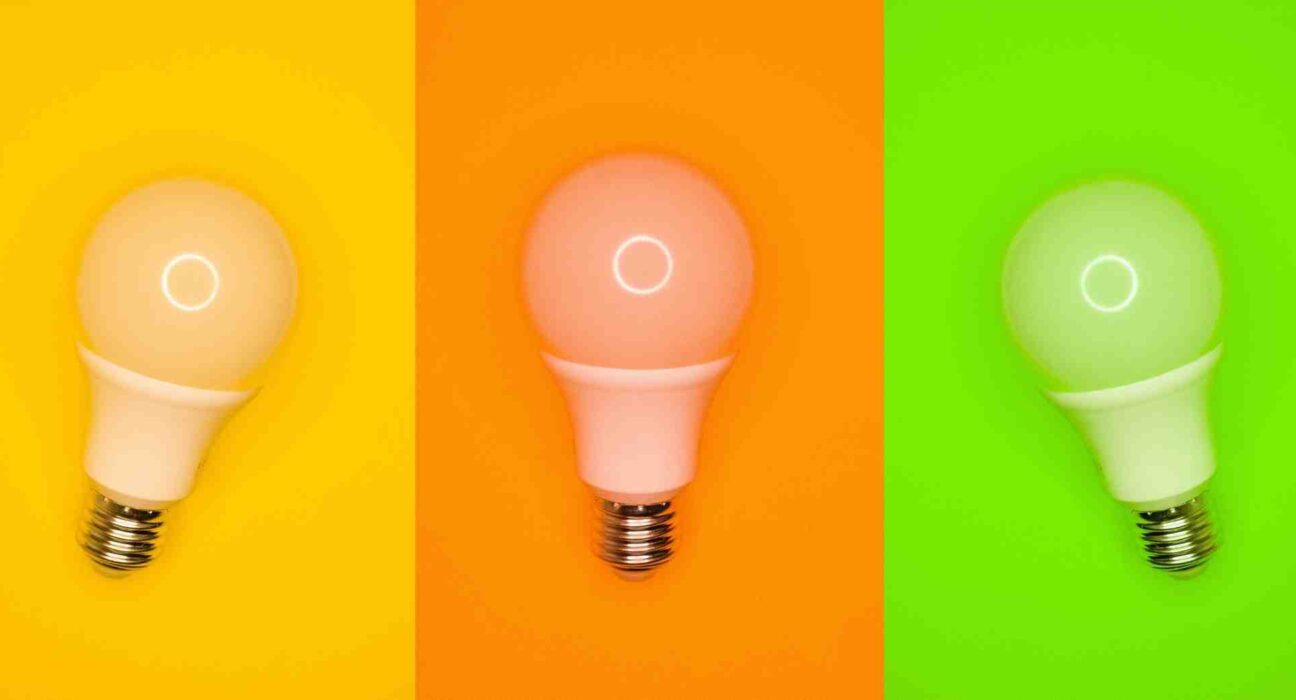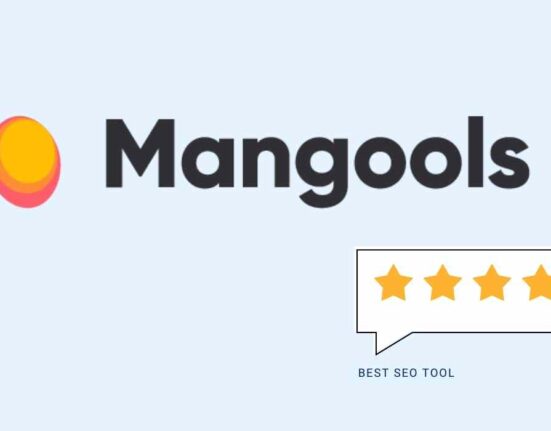What if I told you that you can control the action customers take by leveraging Cognitive biases in marketing, and Supercharge your online business?
Well, does this sound too good to be true? Facts say otherwise, and for centuries, successful marketers have leveraged this secret sauce of cognitive biases to rake in millions of dollars and built thriving brands and businesses. It’s all about understanding deeply how your customers behave, and leveraging the stimuli to which your customers react.
Importance of Cognitive Biases in Marketing
Talking about customer behavior, let’s start with some interesting facts about customers who shop online.
Customers spend less than 15 seconds on an average on a new website.
It takes about 50 milliseconds (0.05 seconds) for customers to form an opinion about your site.
88% of online customers are less likely to return to a site after bad experience.
70% of small business website lack a call to action (CTA) on their homepage.
What’s this got to do with driving your sales, you would say. Well, we know now that customers have a very small span of attention and as digital marketers we need to entice them into trying out our offering and move up the funnel over time to become advocates for our brand. Many digital marketers have used this very effective technique am going to share, to leverage our cognitive biases and skyrocket their brand sales.
Given that customers make such fast decision, often times driven by emotions, if you master the art of spotting the human biases, and create the right stimuli in your design, copy and communication, you can get customers to do what you wish for, and boost your traffic and conversion, driving up your sales.
As we peel this opportunity further, let’s start with understanding what are cognitive biases. They are one of the most used tool by successful marketers, yet one least understood by many.
“Science has shown that we tend to make all sorts of mental mistakes, called “cognitive biases”, that can affect both our thinking and actions. These biases can lead to us extrapolating information from the wrong sources, seeking to confirm existing beliefs, or failing to remember events the way they actually happened!”
Leveraging Cognitive biases is all about understanding the consumer behavior, and integrating approaches to address those opportunities across the funnel to influence customers to take the desired action.
Robert Cialdini, Robert B. Cialdini in his textbook, Influence: The Psychology of Persuasion, has shared some great insights on cognitive biases, which we will further explore to see how some online brands and digital marketers are leveraging to boost their business.
Understanding of these cognitive biases is critical for everyone, whether you are a Digital Marketer wanting to increase your online revenue, a Business person wanting to get more customers, a Sales person negotiating a deal with a vendor, an Investment advisor helping customer make choices, or a customer who is making choices to spot these biases and make the right decision.
Let’s think about a few examples, so we can warm up before we go deep!

Have you ever been to an auction. There are multiple human biases at play, which an unsuspecting eye may not notice. Consistency bias (as you have gone on record saying you like something), Commitment bias (as you have started, you would like to finish), Social proof (as there are other people bidding, it must be good), and more.
Think about the last time you went for that street shopping, did you notice there was a starting price which you negotiated very passionately and then felt good about the purchase. For all you know, the starting price was just an anchor (anchoring effect bias), and the goal all along was to sell you the piece of merchandise at the final negotiated price. A Win-Win I would say, or Not, I leave you to think about that. 😉
These biases are at play all the time, and hence very important for digital marketers to know how to spot and leverage them.
There are more than 185 known cognitive biases in existence (*Source – Wikipedia), but we will cover some of the most influential biases which can hyper boost your business, so read on!
List of Key Cognitive Biases in Marketing
Anchoring Effect Cognitive Bias in Marketing
“The anchoring effect is a cognitive bias whereby an individual’s decisions are influenced by a particular reference point or ‘anchor’.”
Think about that visit you would have made to a car showroom. An individual may be more likely to purchase a car if it is placed alongside a more expensive model (the anchor). Prices discussed in negotiations that are lower than the anchor may seem reasonable, perhaps even cheap to the buyer, even if said prices are still relatively higher than the actual market value of the car.
Example – You would see a price slash across most e-commerce sites, which sets the discount from anchor price, and key technique to entice customers.

Reciprocity Bias
“Reciprocity is a social norm of responding to a positive action with another positive action.”
Remember the free samples during a Supermarket visit or free trials when you shop online – these are not merely opportunities to try product, but rather invitations to engage in the rule of reciprocity.
It is also noteworthy to understand Reciprocal Concessions, which entails an interesting concept called Door in the Face Technique – otherwise known as the Rejection-then-retreat technique, which involves making an outrageous request that someone will almost certainly turn down, and then make the smaller request that was the favor of interest all along.
Example – Music streaming apps like Gaana and Spotify, provide access to most content without upfront payment, and then upsell offerings to the customers.

Consistency Bias
“Consistency bias refers to Incorrectly remembering one’s past attitudes and behavior as resembling present attitudes and behavior.”
Commit to something and then principle of consistency says that we will then feel an automatic compulsion to stick with the decision we’ve already made.
There is another interesting technique called Foot in the Door Technique, where a small request paves the way for compliance with larger subsequent requests.
Example – Remember the free trials which you get on many sites when you shop online. This is one of the most frequently encountered digital marketing technique which encourages consumers to take small actions initially, and then convert them to paying customers once they have started the journey. Clickfunnels is one of the fastest growing site, leveraging this principle quite well.
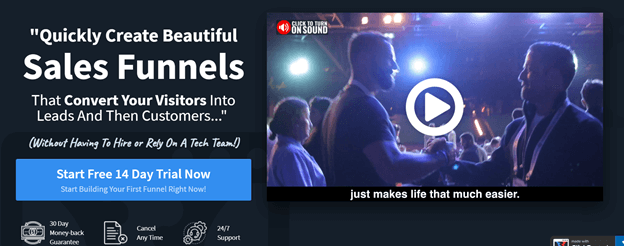
Liking bias
“Liking bias is the idea that we prefer to say “yes” to people that we know and like.”
Robert B. Cialdini in his aforementioned book explores the liking bias with an example from early days of brand Tupperware. Tupperware transformed the buying experience into a fun, energetic in-home Tupperware party, where housewives were incentivized with a small fee to host their sisters, mothers, daughters, and friends to test the storage containers and purchase if inclined. This tactic was effective because it leveraged the liking bias.
Instead of a sales rep showing up at your door for a cold sales pitch, you’re invited to the party of a good friend or family member. You’re far more inclined to say yes to this party than to a stranger at your door. Further, once you’re at the party and you’re introduced to the product, reciprocation tendency, social proof, and the liking bias all work together to get you to buy some Tupperware.
It’s also important to understand the “Halo Effect”, when talking about Liking Bias. Halo effect refers to the tendency where one positive attribute (their good looks) dominates the way we see that person, like when someone is physically attractive, we are more likely to assume they are also talented, kind, honest, and intelligent. We like people who share our interests and Lifestyle, who give us compliments, who are familiar to us, who cooperate with us towards a common goal, and sales people can leverage the halo effect while matching the tone, body language, facial expressions with the customers, to get the customers to like them, and then are able to get buy in for recommended products leveraging this bias.
Example – Many sites like Amazon have a very rewarding affiliate program as one of the key business lever. These affiliates (who enroll with Amazon Associates program) in many cases are influencers or bloggers who have their own community, and promote the products within their groups, which get more footfalls (virtually of course) to Amazon’s site.
Many apps also reward us when we refer them to our friends and social circle, again leveraging this human bias quite effectively.

Consensus bias
“Consensus bias is a pervasive cognitive bias that causes people to see their own behavioral choices and judgments as relatively common and appropriate to existing circumstances”.
This bias is especially prevalent in group settings where one thinks the collective opinion of their own group matches that of the larger population. Since the members of a group reach a consensus and rarely encounter those who dispute it, they tend to believe that everybody thinks the same way.
Example – This bias plays out a lot during research stage by digital marketers, and they can easily fall prey to their own notions of what customer’s would like or not from a UX standpoint. A good example of this is when designing various elements of site, a marketer may feel that the slider (like one below), doesn’t work and ask leading questions from customers during research, thus complimenting their own bias. Some good ways to address this bias during research is to not ask leading questions, take feedback from a diverse group, have more data backed judgement, leverage research techniques which remove such biases.

Authority Bias
“Authority bias is the tendency to attribute greater accuracy to the opinion of an authority figure (unrelated to its content) and be more influenced by that opinion.”
An individual is more influenced by the opinion of this authority figure, believing their views to be more credible, and hence place greater emphasis on the authority figure’s viewpoint.
You would have seen many brands leverage this in mass marketing like Sensodyne having Doctors in the Ad or Neutrogena having Dermatologist Recommended claim across product and marketing material. Many online brands have also leveraged this bias effectively to entice customers to take a targeted action.
Example – Myntra, a leading online fashion portal continues to leverage celebrities and fashion icons, to drive brand resonance, traffic and conversion with targeted campaigns.

Bandwagon Effect or Social Proof Cognitive Bias
“The bandwagon effect is the term used to describe the tendency for people to adopt certain behaviors, styles, or attitudes simply because others are doing so.”
This is one of the most effective strategy used by marketers. I have been in multiple negotiations where I have seen this get result like clockwork, as people tend to make choices influenced by their peers.
For some exclusive brands, there is also a Reverse Bandwagon or Snob Effect which they leverage for greater online sales. “The snob effect is a phenomenon described in microeconomics as a situation where the demand for a certain good by individuals of a higher income level is inversely related to its demand by those of a lower income level.” These brands know their target customers and create exclusive offerings, thus skyrocketing their online sales.
Example – Below is the examples of one of the social shopping sites in India called Limeroad. You will notice how this site very effectively uses the social proof in the way they have built their product and user experience, which makes shopping on this site pretty unique.
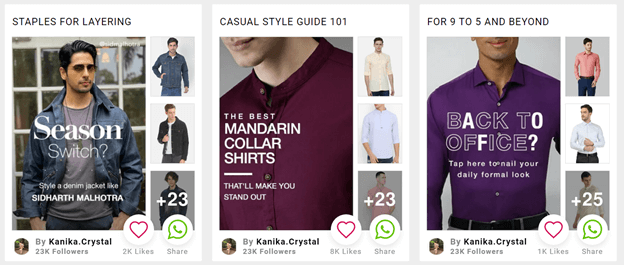
Scarcity bias
“Simply put, humans place a higher value on an object that is scarce, and a lower value on those that are in abundance.”
Has there been a time you were tempted to buy a consumer item because it was almost sold out on shelf, or a car which had months of advance booking. Voila! There was a scarcity bias already at play as you made those decisions.
Example – This bias is leveraged almost ubiquitously on online sites. You will see messages like “Limited Stock”, “Only few pieces left”, “Deal ends in xx hours”. These are all examples of online websites leveraging scarcity bias to boost sales. Check out below example where Amazon has a call out of Deal Ending soon.
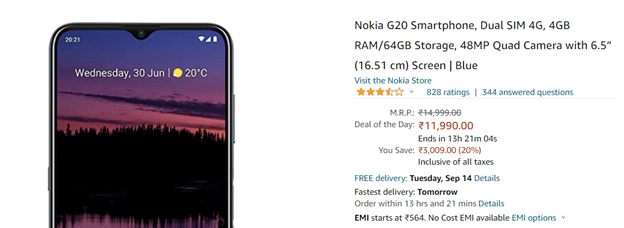
Contrast effect Cognitive Bias in Marketing
“A contrast effect is the enhancement or diminishment, relative to normal, of perception, cognition or related performance as a result of successive (immediately previous) or simultaneous exposure to a stimulus of lesser or greater value in the same dimension.”
The contrast effect was noted by the 17th century philosopher John Locke, who observed that lukewarm water can feel hot or cold depending on whether the hand touching it was previously in hot or cold water.
Example – Amazon does this pretty well in the example below by highlighting the difference when customers opt for prime delivery.

Humor effect Cognitive Bias in Marketing
“The humor effect is a cognitive bias that causes people to remember information better when they perceive it as humorous.”
You can use humor in your design (both in the process and the product) to create a positive user experience. We want to develop positive relationships with our users — humor can help make that happen.
Once someone lands on your site, what’s important as hygiene is that they should be able to tell where they are, what they can do on your site and why they should stick around. This is for building the hook and credibility. And if you can engage your visitors with humor, it will gain you loyal engaged audience.
Example – Remember the memorable campaign from Flipkart where children act as adults, bringing out a fun experience for customers.

Attentional bias
“Refers to how a person’s perception is affected by selective factors in their attention. Attentional biases may explain an individual’s failure to consider alternative possibilities when occupied with an existing train of thought”
The Attentional bias is our tendency to pay more attention to emotionally dominant stimuli, and to neglect other relevant data when making decisions. So, the more something touches us, the more attention we pay to it.
Digital marketers should also be careful of the Backfire effect – When people react to disconfirming evidence by strengthening their beliefs. Appealing to rationality won’t change deeply held beliefs.
Example – Create a compelling emotional copy to engage and inspire your customers. Show how will improve their lives, not how awesome product or service is. This ad from Gillette captures the imagination of customers and has helped the brand create great resonance and recall with customers.
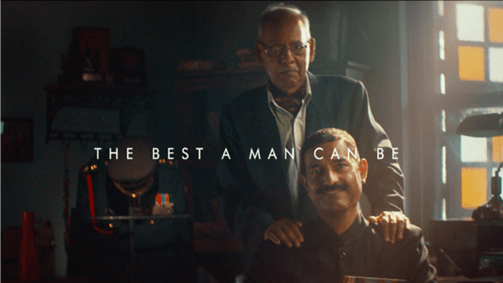
Availability Cascade Cognitive Bias Example
“Availability cascade is a mental shortcut that occurs when people judge the probability of events by how easy it is to think of examples.”
Example – If you are an e-commerce site, spread the CTA (Call to action links) link throughout the page, to influence customers through the conversion funnel. From a marketing standpoint, think about how you can create viral campaigns like the one by Amazon shown here, which captures the imagination of customers with high recall.
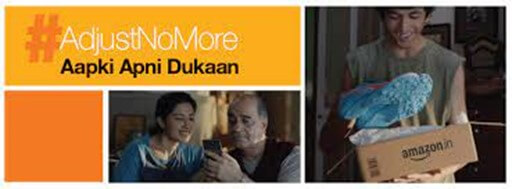
Loss aversion bias
“Loss aversion is a cognitive bias that describes why, for individuals, the pain of losing is psychologically twice as powerful as the pleasure of gaining.”
Loss aversion refers to an individual’s tendency to prefer avoiding losses to acquiring equivalent gains. Simply put, it’s better not to lose $50, than to find $50.
Example – Promote free trials of your product, to get consumers to try out your product or service, and then leverage other stimuli to continue to engage with customers and drive conversion for your business.
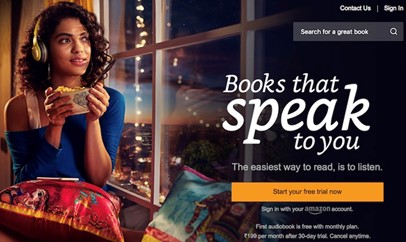
Confirmation bias
“Confirmation bias is the tendency to search for, interpret, favor, and recall information in a way that confirms or supports one’s prior beliefs or values.”
We tend to look at data and insights, in a way that confirm our own beliefs and values, and as digital marketers we should be aware of this bias.
Some interesting concepts emerge when thinking of confirmation bias:
1) Attitude polarization – when a disagreement becomes more extreme even though the different parties are exposed to the same evidence;
2) Belief perseverance – when beliefs persist after the evidence for them is shown to be false;
3) The irrational primacy effect -a greater reliance on information encountered early in a series; and
4) Illusory correlation – when people falsely perceive an association between two events or situations.
Example – During research with your customers, make sure that the insights you obtain have statistical significance. Also, be aware of your own biases as you look through data and insights, to identify the customer opportunity.

Framing effect Cognitive Bias
“The framing effect is a cognitive bias where people decide on options based on whether the options are presented with positive or negative connotations; e.g. as a loss or as a gain.”
Prospect theory shows that a loss is more significant than the equivalent gain, that a sure gain is favored over a probabilistic gain, and that a probabilistic loss is preferred to a definite loss.
So what would work best you may say – Positive or Negative Framing. And the answer is, it depends. 😊 People’s responses are influenced by the way a piece of information is presented to them, and the bottom line is that positive and negative framing can both work. It’s important to A/B test both, and optimize your strategy based on the metrics you gather from your own platform and sales.
Here’s how you can use Framing effect to your advantage in driving your online business sales.
E.g. If your goal is to sell a pair of athletic shoes
Positive Framing: Focus On Gains – Your body will bless you. These pair of shoes will inspire you to get active and keep your body in it’s best shape!
When using positive framing, you want to focus on what the buyer is getting. They’re gaining something. They’re making progress or growing in some way.
Negative Framing: Make them Afraid to Lose – Why put a hole in your pocket with expensive shoes. Here’s the most functional shoes in market with best value for your money.
When using negative framing, you want to make buyers afraid of losing out on something. Negative framing taps into peoples’ natural fears—of loss, or of missing out. Buying your product will prevent a negative outcome.
Example – Seen those ads where sunscreens advertise they prevent cancer. (here you go, negative framing in action.) Seen the Coke zero ad, which promotes the health aspect of the drink (positive framing of the product.)
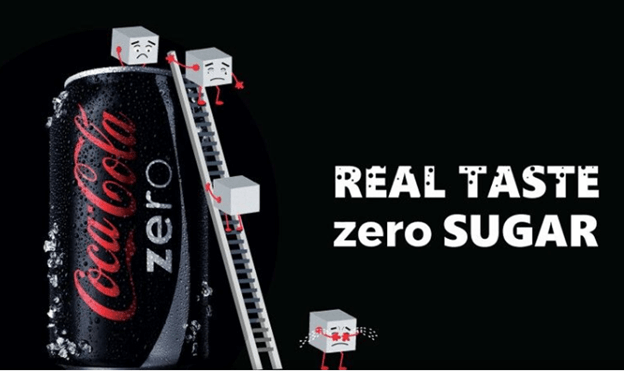
Choice Support bias (Post purchase rationalization)
“Choice-supportive bias or post-purchase rationalization is the tendency to retroactively ascribe positive attributes to an option one has selected and/or to demote the forgone options.”
It is part of cognitive science, and is a distinct cognitive bias that occurs once a decision is made. So, as marketers and business owners, our task does not stop at selling our product or service, but connecting and inspiring customers post purchase as well, to drive more positive product experience and hence more repeat business.
Example – Here’s a mail from an Online Travel Agent, post the purchase, calling out the positive aspect of what the customer purchased, thus delighting the customer while addressing this bias and driving more loyalty for the brand.

Context effect Cognitive Bias in Marketing
“A context effect is an aspect of cognitive psychology that describes the influence of environmental factors on one’s perception of a stimulus.”
Context effects can influence consumers’ choice behavior. There are three main context effects that are researched in marketing, which all digital marketers should know:
- Objects that are priced in the middle of choice sets are looked on more favorably. The middle choice seems like a good compromise between choices that may be viewed as too extreme.
- One item will increase the attractiveness of another item that is similar, but superior to it. By showing that an item is superior to a similar one the likability and possible purchasing power of the superior item increases.
- Two or more similar items competing for attention they will only detract from each other in the marketplace.
Example – This is an example of HBR subscription models. And the middle option is more of a compromise option to upsell the offer to customers.
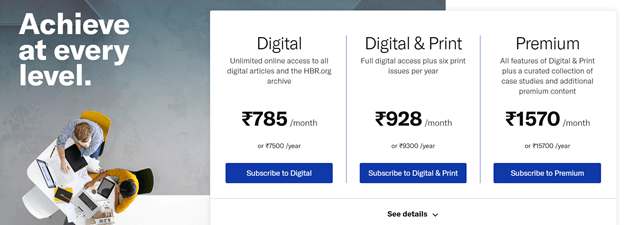
And now, the masterstroke which digital marketers use in design and communication, to win our customers:
Lollapalooza effect Cognitive Bias in Marketing
Charlie Munger used the term “Lollapalooza effect” for “multiple biases, tendencies or mental models acting in compound with each other at the same time in the same direction. With the Lollapalooza effect, itself a mental model, the result is often extreme, due to the confluence of the mental models, biases or tendencies acting together, greatly increasing the likelihood of acting irrationally.”
This compounding of multiple biases acting together creates a powerful stimuli in customers mind to take action, and used correctly can supercharge the online website sales.
Example – One of the most familiar example is seen while shopping at Amazon, where multiples biases are being leveraged to drive customer action and boost online brand sales.
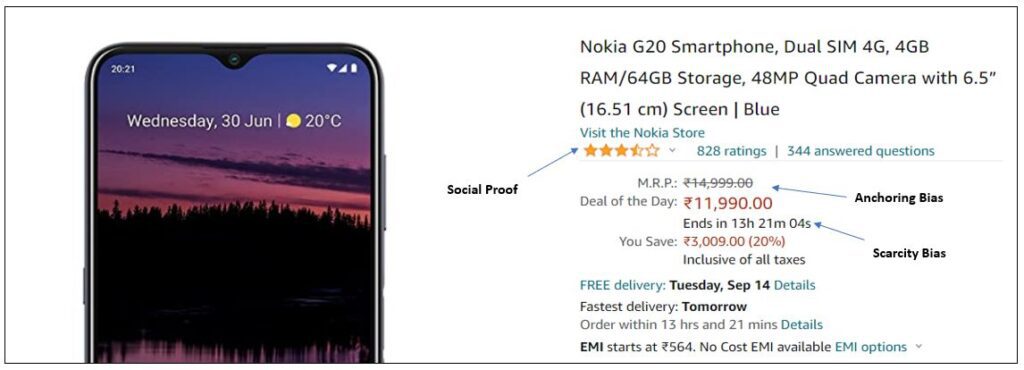
Conclusion: Cognitive Biases in Marketing
Well, this brings us to the end of this writeup. Congratulations, you have made it till here and hopefully got yourself equipped with one of the most powerful tool to communicate with and influence your customers, and supercharge your business!
Also, talking about communication, check out this another interesting read where I have distilled my experience, to share a secret formula with you which I have used consistently to build multiple million dollar brands, which will help you create business or brand which will stick with customers and further boost your business.





